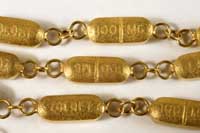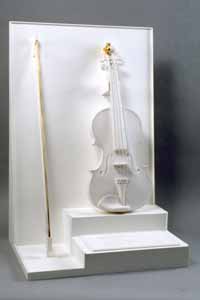With the closing of Lisa Gralnick: The Gold Standard at the end of the month, we decided to ask the staff to share their favorite pieces from this expansive exhibition, which is comprised of Gralnick’s work from the past seven years. The show is up through Saturday, May 28, 2011. If you’ve visited the show, please share your favorites in the comments below!
Julie Farr, Executive Director, writes about enjoying the works in Part I: Commodification and the Sensible Economy. She loves that Gralnick honors the original intent of the gold by preserving people’s sentimentally charged objects as plaster artifacts of emotion.
Communications Director, Mary Headrick, is fascinated by all of Part I: Commodification and the Sensible Economy. “I like the dual effect of first seeing a piece that is visually intriguing and then reading the text, which gives each piece a deeper meaning. After you see a few pieces, the whole concept really clicks. They’re all so clever. My favorites are probably Rhinoplasty, Zoloft, and the Italian Shoes.
Education Director, Carol Klahn, chose the Coin Collection Picture Gallery in Part III: Transubstantiation and the Historicized Object as her favorite because of her love of art history. She loves the ambiguity of the tiny paintings and that many of them seem to be variations on historical designs. She enjoys that there are many things that are familiar about the designs of the miniature gouache paintings, but that it is hard to pinpoint all of the influences. She also likes these because she is a fan of gouache paintings and loves the way they contrast with their gold frames.
An avid coffee drinker, Volunteer Coordinator, Marina Lewis enjoys Lisa Gralnick’s #7 Starbucks Coffee. It reminds her of how expensive coffee can be and to enjoy it.

Curatorial Assistant, Ashley Powell, chose #6 Zoloft in Part I: Commodification and the Sensible Economy. She found the piece to be clever and a bit humorous because the artist has managed to put a price or value on happiness / mental health. She also likes the way Gralnick used only a portion of the gold needed to equal the monetary value on the medicine bottles, and with the rest of the gold she made a beautiful necklace with beads in the shape of Zoloft pills.
Asher Gallery Manager, Suzanne Sippel’s favorite is #4 Violin in Part I: Commodification and the Sensible Economy. She appreciates this piece because it was cast from Gralnick’s own violin and the investment the artist has in this piece because of that incredibly personal touch. She also identifies with this piece because Gralnick is displaying herself as not only an artist but a musician as well.

Asher Gallery Sales Associate and Gallery Attendant, M’kina Tapscott, chose # 3 Cell Phone in Part I: Commodification and the Sensible Economy as her favorite because this piece works on multiple layers. It is a historical account of technology because of its dated and antique look, resembling a home phone of today more than a cell phone. The work is also a documentation of the price of gold at that time and how it has increased over the years.
Asher Gallery Sales Associate, Zoya Tommy, likes the #1 Sink in Part I: Commodification and the Sensible Economy because it is the focal point of the show. She is interested in the way it’s positioned in the show and the way it stands out because of its isolation. She also appreciates this piece because of its domesticity and she has seen other works that use sinks and finds it interesting to see how different artists work with this subject.
#17 Duncan Painting in Frame in Part I: Commodification and the Sensible Economy is Curator, Anna Walker’s favorite. She appreciates that it is a reference to an art object, a painting in this case, and how the value would usually be based on the image. However, Gralnick has removed the image, causing the viewer to confront how we value art. Walker also likes how well executed the gold corner of the piece is, from transitions in texture from canvas to frame.
Jenny Lynn Weitz, Web and Marketing Assistant, likes every single piece from Part II: Phenomenology and Substantialism because of the heavily personal stories behind each melted item. “I think that Lisa did a great job cataloging the owner’s reasoning for selling their valuable gold belongings to her to melt, and then create the pieces for Part III. Through the label descriptions, we can see that some of the items in Part II are there because of broken marriages, deceased relatives, economic hardship, all of which are incredible emotional, intriguing… it makes me want to know more about all the previous owners, see pictures of them or know how they feel about this exhibition.”

Nyala Wright, Associate Director of Fundraising, chose the Fourteen Unusually Small Rings in Part III: Transubstantiation and the Historicized Object because of their delicateness and beauty. They make her wish she had tiny fingers so she could wear them.
If you’ve had a chance to visit the exhibition share your favorite below. We hope you will stop by to see this great show before it closes May 28!

